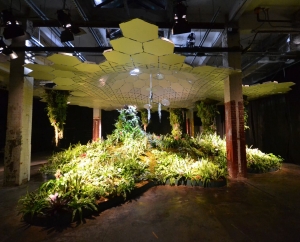
Every city seems to want more parks. And, when real estate is at a premium and park land is scarce, officials often develop parks in very strange places.
New York City, the nation’s largest city, recently announced plans to convert vacant underground space in a subway station into a park. This very strange space, which covers about an acre, has been vacant since 1948.
Dubbed the “Lowline,” it is being billed as the world’s first underground park. Estimated to cost $60 million, the park will feature a large plaza for events, space for classes and areas that have plants and trees. Some of the track and platforms of the old trolley will be preserved and lighting will be provided by solar technology that gathers sunlight through skylights.

The Lowline, New York
By Jcbergland CC BY-SA 4.0
The Lowline is a distant cousin to the city’s High Line, an elevated urban park and greenway completed in 2014 that resulted from repurposing an abandoned railway in Manhattan. That’s a strange place to develop a park but the result has been incredible – about a billion dollars of re-development around the area is the first few years.
Young professionals gravitate toward downtown living so they can be close to their jobs, recreation and entertainment. Affluent retirees also like urban living. Pocket parks, often created on a single vacant lot of two acres or less, or on small, irregular shaped pieces of land, are popping up in many of those areas.
Texas cities have not been short on innovative solutions for providing park space for communities in high-density population areas. The downtown areas of Austin, Fort Worth and San Antonio all have green spaces and many have pocket parks that have been created on vacant lots. Pocket parks are being developed throughout the country and, whatever the size, they quickly become destinations for people who live near them.
In Dallas, the Klyde Warren Park was built over a recessed eight-lane freeway. Who would have thought of that? The park, however, is pretty incredible. It covers 5.2 acres, includes a performance space, food vendor locations, a dog park and playgrounds. No land had to be purchased because it was built over a highway in a space that otherwise likely would have gone unused. The $110 million park project was funded through a public-private partnership (P3/PPP). Owned by the city of Dallas, the park is operated and managed by a private foundation.
Another P3 was responsible for the redevelopment of Houston’s Levy Park, an established but underused and often ignored 6-acre park near the Southwest Freeway. The park is currently undergoing a $15 million facelift and will be maintained and supported by revenues from a 99-year ground lease by a mixed-use commercial development adjacent to the park. Recent projects include a luxury apartment building, an office building and restaurant space.
Public officials have become creative about parks and greenspaces and the benefits are obvious – higher property values, less crime, healthier lifestyles, more retail enhancements and higher tax revenue for city coffers. Everyone wins! Hats off to developing parks and greenspace in any location – strange or not!
